Understanding the Brain
Many scientists think the brain is the most amazing thing in the whole universe. Different parts can help us with different things – with our focus, with making decisions, with keeping ourselves calm and with helping us to remember things.

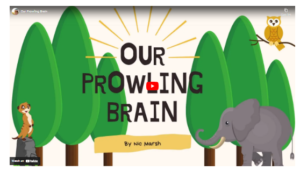 Watch at https://www.youtube.com/watch?v=BNxlwhpJxxE
Watch at https://www.youtube.com/watch?v=BNxlwhpJxxE
Mrs Kate Drennan’s “Understanding the brain” notes
(Designed for teacher information but could be adapted)
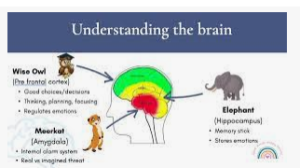
Script to help explain this to children
“There are 3 main parts of the brain and we can liken these to animals to help us remember.
First, we have the meerkat. The scientist name is amygdala (a-mig-da-la)
What do we see meerkats doing? Yes, that’s right they scan their environment for danger and that’s what our meerkat part of the brain does. It keeps a look out for any kind of threat when it thinks we might be in danger! It keeps you safe.
The next part of the brain is the elephant. This part of the brain has the job of helping you to store memories and information. It is like our library. We call it elephant because elephants never forget! The scientists call this part the hippocampus. What is interesting about this part is that it also stores how we feel about those memories. So, for example, if you were chased by a dog and felt frightened, it will remember that. Or if you stood up to speak in front of lots of people and felt nervous, it will remember that too.
The third part of our brain is the wise owl. Scientists call this the pre-frontal cortex. Place your hands on your forehead. The wise owl is just behind your hand. It helps you to focus, to make the right decisions and to keep your emotions under control. It helps us learn and do our best at anything. It also helps us to calm down when we are feeling upset, worried or angry. This part of our brain starts to develop at 4 but doesn’t finish until we are 25 which is why it is so difficult sometimes to manage those BIG feelings that we have.
When you are happy, feeling calm, these animals work well together. You can focus and learn really well.
The problem is that our meerkat is SO good at keeping us safe that sometimes it is activated even when there isn’t a real danger, for example when we are angry, upset or worried. When this happens, our meerkat completely takes charge of the brain to keep us safe and our wise owl flies away!! This means we cannot think straight or learn. Our elephant hides too so we cannot remember how to calm down.
Think back to the last time you felt angry. What did it make you want to do? (Hit, shout, scream, cry?) That is because our wise owl which helps us stay calm and make good choices has flown away!
But luckily there are things that we can do to, like focusing on our breathing or focusing on our senses that can reassure your meerkat that everything is ok. Once you do this, you should be able to calm down and focus again on your learning.”
Dear You- A letter from your brain!– especially for KS2 (Y3-Y6)
The video below describes how the brain works in a way which is easy to understand and will hopefully help you when you are supporting your children and young people. (Slight differences in the terminology used above e.g. animals but the same message).
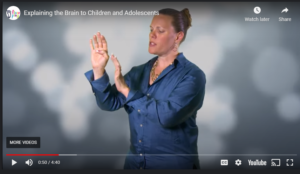 Watch at https://www.youtube.com/watch?v=py8deTlxNco
Watch at https://www.youtube.com/watch?v=py8deTlxNco
Brain Breaks for Children
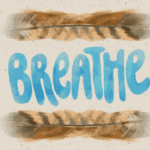
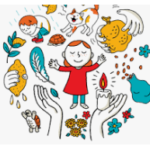
https://www.savethechildren.org.uk/what-we-do/coronavirus-information-advice/relaxation-exercises-to-do-at-home-with-your-kids
What is Hand Breathing?
During hand breathing, children concentrate on taking slow breaths in through their nose and out through their mouths. Children may need to practice this first as they may be mouth breathing. If you notice that your child finds breathing through their nose a challenge, invite them to imagine they are smelling a beautiful flower or their favourite food as they breathe in, and then to breathe out through their mouth with a big sigh. At the same time as breathing, children will focus on the action of tracing up and down the fingers of one hand and the gentle sensations this creates. Here is how it works:
Five Steps to Feeling Calm (use this as a guide to teach your child)
-
Spread your hand and stretch your fingers out like a star. You can choose your left hand or your right hand. Pretend the pointer finger of your other hand is a pencil and imagine you are going to trace around the outline of your hand and fingers.
-
Start at the bottom of your thumb and slide your finger up your thumb, pause at the top, and then slide your finger down the other side. Now slide your pointer up your second finger, pause, and slide down the other side. Continue tracing your fingers up, pause, and down. Slide your finger slowly, watch your finger move and notice how it feels. Keep going until you have finished tracing your fifth finger (pinky).
-
Now you are ready to add some breathing. Breathe in through your nose and breathe out through your mouth. Remember to keep it slow and steady.
-
Place your pointer finger at the bottom of your thumb, and breathe in as you slide up. Breathe out as you slide down. Breathe in as you slide up your second finger, and breathe out as you slide down. Keep going until you have finished tracing your fingers and you have taken five slow breaths.
-
How does your body feel now? Do you feel calm or would you like to take another five?

